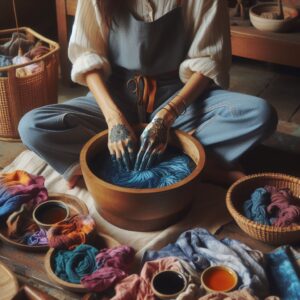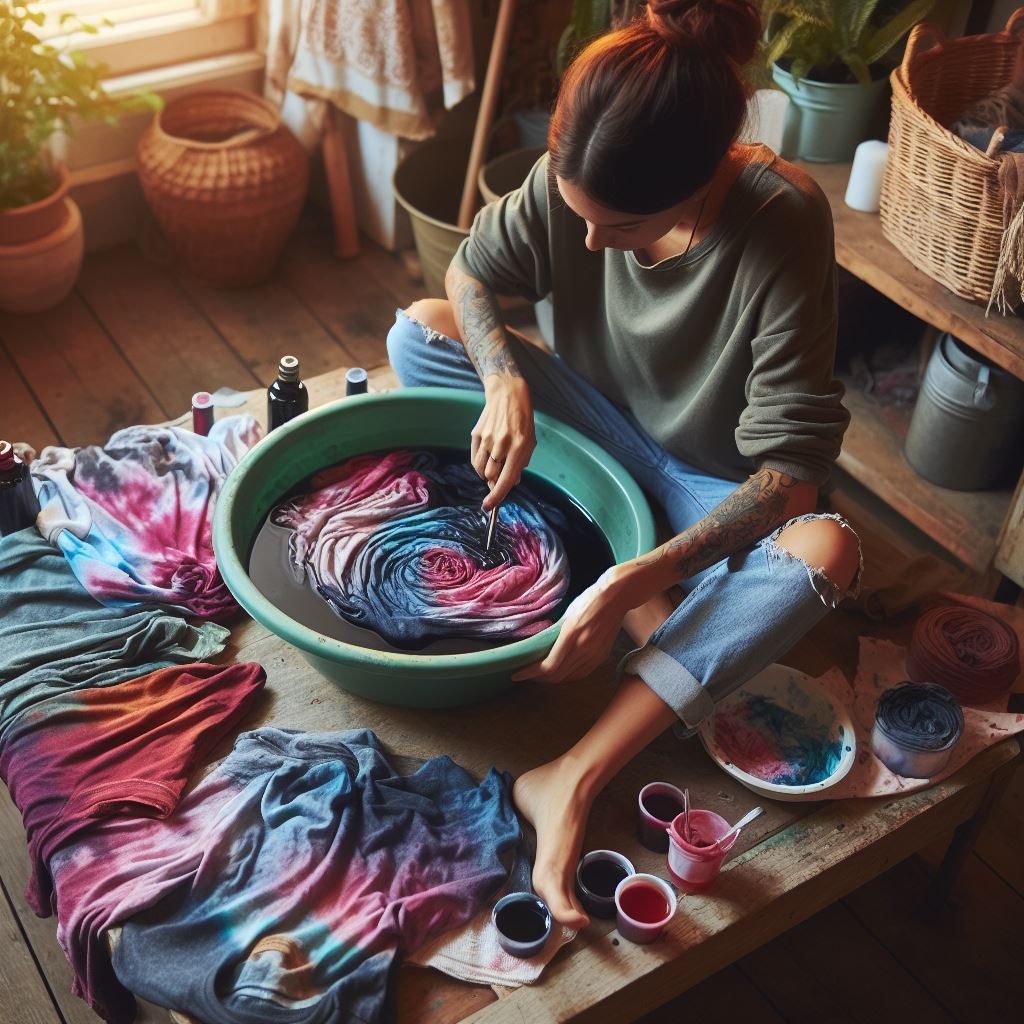Tie-dyeing is a fantastic way to infuse vibrant colors and creative designs into fabrics. Yet, the key to preserving those brilliant hues lies in the setting process.
Many enthusiasts wonder whether they should set tie-dye immediately after dyeing or if there’s flexibility in timing.
Let’s unravel this colorful conundrum.
Understanding Tie-Dye Setting
When you’ve completed the dyeing process, the next step involves setting the colors. Setting essentially means making the dye chemically bond with the fabric fibers. This ensures the colors remain vivid and don’t bleed or fade excessively during washing.
Setting Immediately vs. Delayed Setting
Immediate Setting: Some dyers advocate for immediate setting to lock in the colors. This involves keeping the tied fabric in place and allowing the dye to set for a specific duration, as recommended by the dye manufacturer. It typically involves wrapping the dyed fabric in plastic to keep it moist, which aids in the setting process.

Delayed Setting: On the flip side, there’s the option of delaying the setting process. This approach involves rinsing the fabric after dyeing to remove excess dye, letting it dry, and then setting the colors later. This delay gives the dye time to penetrate the fabric before setting.
The Verdict: Immediate or Delayed Setting?
Both methods have their merits, but immediate setting tends to be more commonly recommended. The immediacy locks in the dye’s vibrancy before it has a chance to wash out. However, some dyers find success with delayed setting, especially with certain dyes or techniques.
Tips for Effective Tie-Dye Setting:
- Follow Dye Instructions: Always adhere to the specific dye manufacturer’s instructions for setting. Different dyes might have varying setting requirements.
- Prevent Color Bleeding: If setting immediately, ensure the fabric stays moist by wrapping it in plastic to avoid color bleeding.
- Consider Fabric Type: Certain fabrics may require different setting methods. Natural fibers like cotton or rayon often respond well to setting, while synthetics might need different techniques.
So,…
Setting tie-dye immediately after the dyeing process is generally recommended for vibrant and long-lasting colors. However, experimenting with delayed setting can also yield interesting results. Remember, following dye instructions and considering fabric types are crucial for achieving the best outcomes.
Whether you opt for immediate or delayed setting, the joy of tie-dye lies in experimentation and creative exploration. So, grab your dye bottles, unleash your imagination, and let the tie-dye adventure begin.
Mastering Tie-Dye: Unveiling Further Insights
Let’s dive deeper into the nuances of tie-dyeing, exploring additional aspects beyond the setting process.
1. Choosing the Right Dye
Selecting the appropriate dye sets the foundation for a successful tie-dye project. Consider the type of fabric you’re dyeing and choose a dye that complements it. For instance, fiber-reactive dyes work well with natural fabrics, providing vivid and lasting colors.
2. Fabric Preparation
Before diving into the dyeing process, ensure the fabric is prepped. Wash it to remove any finishes or impurities that might hinder dye absorption. For best results, ensure the fabric is damp before applying the dye.
3. Exploring Tie-Dye Techniques
Tie-dyeing isn’t just about random patterns; it’s an art with various techniques. From classic spirals and bullseyes to shibori and ice dyeing, each method yields unique and stunning designs. Experiment with different folding, twisting, and tying techniques to create your signature style.
4. Considerations for Setting
Apart from immediate and delayed setting, other factors influence how well your tie-dye sets. Temperature and duration play crucial roles. Some dyes might require heat setting by ironing or putting the dyed fabric in a hot dryer, while others might need soaking in a fixative solution.
External Resources for Further Reference:
To delve deeper into tie-dye techniques and best practices for setting, here are three reliable resources you can explore:
- Tie Dye Instructions by Dharma Trading Co. – Offers comprehensive tie-dye tutorials and setting recommendations.
- Tips for Setting Tie-Dye Colors by The Spruce Crafts – Provides insights into various methods of setting tie-dye colors.
- Tie-Dye Techniques and Projects by Martha Stewart – Features creative tie-dye projects along with setting guidance.
- Procion Dye Instructions by Jacquard Products – A comprehensive guide to using Procion MX dyes, commonly used in tie-dyeing.
In Conclusion:
Tie-dyeing is a blend of creativity and chemistry, offering a canvas for artistic expression. Remember, there’s no one-size-fits-all approach. Embrace experimentation, explore diverse techniques, and let your imagination run wild to create captivating tie-dye masterpieces.
Whether you’re a novice or an experienced dyer, the joy of tie-dye lies in the journey of discovery. So, gather your supplies, embark on your dyeing adventure, and revel in the kaleidoscope of colors that tie-dye brings to life.
Comparison tabular
| Aspect | Immediate Setting | Delayed Setting |
|---|---|---|
| Process | Fabric is left tied, allowing dye to set immediately after dyeing. | Fabric is rinsed after dyeing, dried, then colors are set later. |
| Color Locking | Locks in colors quickly for vibrant and lasting results. | Colors may have slightly less vibrancy but offer different effects. |
| Moisture Retention | Usually involves wrapping fabric in plastic to keep it moist. | Fabric is allowed to dry before setting the colors. |
| Recommended For | Generally recommended for most tie-dye projects. | Used by some dyers for experimenting with unique color effects. |
| Risk of Bleeding | Slight risk of colors bleeding if not wrapped properly. | Reduced risk of bleeding as excess dye is rinsed before setting. |
Final words
Tie-dyeing isn’t just a craft; it’s a vibrant journey into a world of colors and creativity. Whether you choose to set your colors immediately or delay the process, the beauty of tie-dye lies in the boundless possibilities it offers.
So, grab your fabrics, mix your dyes, and embark on your tie-dye adventure! Whether you’re aiming for vivid, immediate hues or exploring the subtleties of delayed setting, let your imagination flow freely. Experiment, create, and infuse your world with bursts of color that reflect your unique style.
Remember, the joy of tie-dyeing isn’t solely in the end result; it’s in the process itself. Embrace the unexpected, celebrate the imperfections, and revel in the kaleidoscope of colors that you bring to life through this captivating art form.
May your tie-dye endeavors be filled with joy, creativity, and a riot of magnificent colors! Happy tie-dyeing

For over a decade, I’ve been Mike, an artist, crafter, and designer deeply immersed in the Croc world. I thrive on crafting unique, size-inclusive patterns, fostering creativity, and sharing them on ktforum.com. My designs aim to ignite your creative spark and delight you, ensuring clarity and ease of use through rigorous testing. Join me in expressing your creative flair and showcasing your craft with joy.
Related Posts
- Accelerating the Tie-Dye Setting Process: Hairdryer or Fan?
Tie-dyeing is an art form that’s not just about colors; it’s about patience and precision.…
- Understanding the Impact of Sunlight on Setting Tie-Dye
Tie-dyeing is a vibrant and creative way to add a burst of color to fabrics.…
- Setting Tie-Dye in a Refrigerator: Is It Possible?
Tie-dyeing has made a bold comeback in the fashion world, offering a vibrant and personalized…
- Understanding Tie-Dye Settling and Mixing with Other Dye Projects
Tie-dyeing is a vibrant and creative way to infuse life into fabrics, but ensuring colors…

